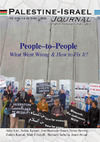The written report in front of me looked reasonable-a long list of projects, money going in and going out, about $800,000 all together. I could definitely hand in the report, thank the Norwegian guest and enter into a routine discussion about the stormy political situation.
I could not, however, do so. I knew that the written report was false. Most of the projects had to be canceled, or had become completely meaningless under the circumstances. During some of those that were somehow carried out, there were even Israelis and Palestinians who had engaged in fist fights, or at least in yelling at each other.
I knew exactly how marginal the people-to-people activities had become. The ministry's staff was lobbying, on a daily basis, inside the Israeli security establishments for entry (to Israel) or exit (from Israel) permits for the Palestinian participants. Our requests were usually rejected. Often I had to personally intervene and even then our success was very limited.
The written report did not tell this story- the different non-governmental organizations assigned to carry out the projects needed the Norwegian money. In most of the cases they had to spend most of the sums before the project was canceled. As a result, many organizations had to pretend as if the programs had been successfully carried out. I decided to tell the truth, and described to my guest the situation as it was on the ground, not on paper.
Bad News Not Welcome
The Norwegian diplomat's reaction caught me by surprise. He simply refused to accept the bad news. He did not appreciate at all my sincerity. It looked like I had spoiled his day, if not his whole trip to our region. He did not believe me and responded aggressively, accusing me of trying to discourage Norway from its brave and important mission. The report he received from his Palestinian counterparts was probably very different and he preferred the good news to the bad ones. It looked for a moment as if I cared more about the efficient spending of the Norwegian tax-payers money, than did the Norwegian government itself.
I must admit I was shocked. As someone who was massively involved in informal track two and people-to-people efforts during the 1990s, and came back to government service (with Prime Minister Ehud Barak) to try to advance peace, I thought I deserved more credit. In the eyes of the Norwegian diplomat I became the obstacle to peace.

An Israeli-Palestinian Students Workshop (Peres Center for Peace)
People-to-People Requires a Non-Violent Atmosphere
The story has of course a much wider context. In the Israeli-Palestinian reality, the people-to-people activities could become meaningful and effective mainly when they are carried out in an overall non-violent atmosphere, which only rarely existed. The activities usually became meaningless during the periods of tension (when they were especially needed), and possible when the government-to-government channels were open.
The reason was very trivial: the unofficial contacts had to be blessed by the upper echelons on the Palestinian side and, for all practical purposes, also by the Israeli security establishment that was fully controlling the movement of the Palestinian participants. When the Palestinian participants were PLO members, they needed the approval of Chairman Yasser Arafat. If they were not PLO members, many other obstacles popped up. We often got the feeling that Arafat saw the Palestinian civil society as competing with the PLO for outside funds that he preferred would reach him directly. As for the Israeli security authorities, they had on their blacklist almost every meaningful Palestinian activist that was ready to be included in the people-to-people political dialogue.
The non-democratic environment on the Palestinian side, and the exaggerated security measures on the Israeli side, often led to situations where, in track two meeting, a senior Israeli group found itself in the room with a group of Palestinian youngsters who had come for a pleasant hotel vacation (often with their families) to run away from their misery at home.
There were exceptions. Here and there we could meet Marwan Barghouti or Faisal Husseini in track two meetings. These were very important dialogues, but the personal contacts became of no importance when things on the ground deteriorated. We could still speak on the phone or even like each other on a personal level, but the personal touch was not able to soften the content of the conversation, or change the violent realities.
We Should Not Stop Trying
Generally speaking the Palestinian-Israeli people-to-people efforts have so far failed, as have the private track two initiatives. This does not mean we should stop trying. Now, after the Hamas victory in the Palestinian general elections, the unofficial channel may become more important. We have met only PLO people in the last 15 years. We had known the Hamas activists only through gun-sights. The personal unofficial contacts can become especially important as the official ones are not in the pipeline. However, we should carefully draw our conclusions from the last frustrating decade. Future people-to-people contacts should adjust their nature, as far as possible, to the internal political changes on the Palestinian side, and to the overall security worries on the Israeli side.
While it is important to continue productive people-to-people meetings with PLO people who support a two- state solution, we also have to find a way to include Hamas representatives in these people-to-people activities. The Palestinian participants, on their side, will have to be less sensitive to the Israeli security measures. The security demands might often become humiliating, but we were given outstanding reasons to be very fearful of Palestinian behavior.

